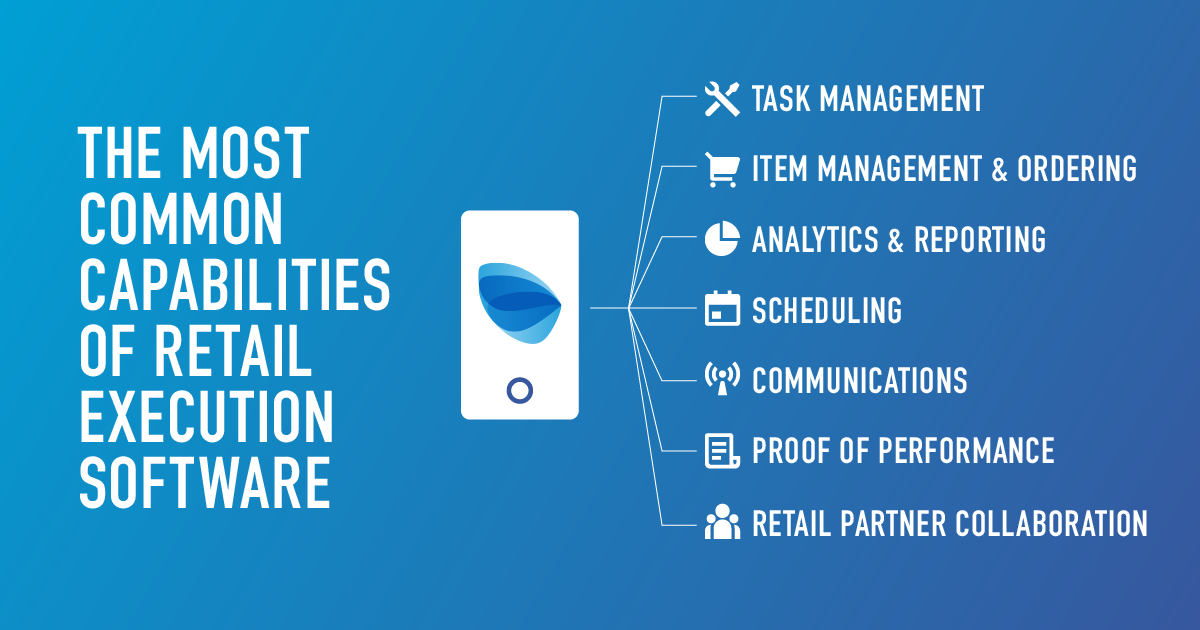The Ultimate Guide to Retail Execution Software
Enhance In-Store Performance with Advanced Retail Execution Software
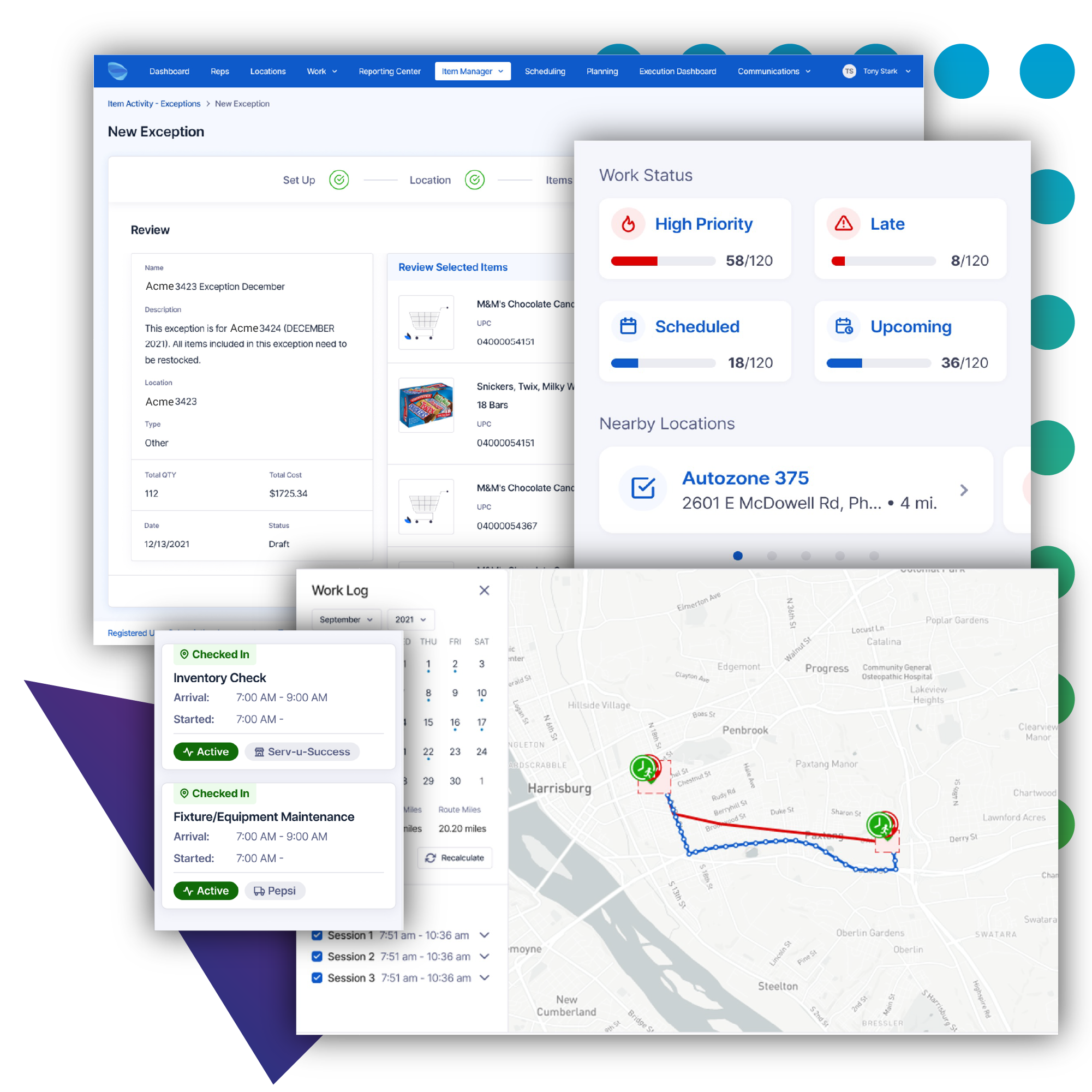
Introduction: What is Retail Execution?
Retail execution is a critical aspect of the consumer goods industry, encompassing all activities carried out in-store to ensure that products are presented, promoted, and sold effectively. Efficient retail execution directly impacts sales and profitability, making it essential for companies to streamline these processes. Retail execution involves tasks such as stock replenishment, planogram compliance, promotional display setup, and shelf management. Ensuring these activities are performed flawlessly can be challenging, especially for companies managing multiple retail locations. This is where retail execution software becomes invaluable.
Retail execution software is designed to enhance the efficiency and effectiveness of in-store operations. It provides tools for managing and optimizing various aspects of retail execution, from inventory management to sales analytics. With retail execution software, companies can automate many routine tasks, allowing their field teams to focus on strategic activities that drive sales and improve customer experience.
One of the primary benefits of retail execution software is improved data accuracy. Traditional methods of retail execution often rely on manual data entry, which can be prone to errors. Retail execution software, on the other hand, allows for real-time data collection and analysis. Field teams can use mobile devices to capture information on stock levels, shelf placement, and promotional displays. This data is then synced with the central system, ensuring that decision-makers have access to accurate and up-to-date information. This real-time data enables quicker and more informed decisions, leading to better retail execution outcomes.
Another advantage of retail execution software is enhanced communication and collaboration. The software provides a centralized platform where field teams and headquarters can share information and updates seamlessly. This ensures that everyone is on the same page regarding retail strategies and execution plans. For instance, if a new promotional campaign is launched, the details can be communicated instantly to all relevant parties, ensuring that the campaign is executed consistently across all locations.
Products must be priced correctly, in accordance with the latest promotional strategies. Shelves and displays must be positioned according to strict planogram specifications. Fresh food, in the case of grocers, must be sold and replenished within short shelf-life windows. Sales and on-hand stock quantities must be meticulously tracked to account for theft and other shrink-related losses (and to inform consumer behavior analysis and larger strategic decisions around selection and assortment).
In the industry, we refer to this complicated juggling act of in-store activities as retail execution—alternative terms include Retail Activity Optimization (RAO) or Retail Execution & Monitoring (REM).
Moreover, retail execution software offers robust analytics and reporting capabilities. Companies can track key performance indicators (KPIs) such as sales volume, stock turnover, and compliance rates. These insights help in identifying trends, spotting potential issues, and making data-driven decisions to optimize retail execution. For example, if a particular product is not performing well in certain stores, the company can investigate and address the issue promptly.
Additionally, retail execution software enhances field team productivity. The software often includes features such as task management, route optimization, and photo capture, which streamline the daily activities of field representatives. By automating routine tasks and providing clear guidelines, the software enables field teams to work more efficiently and focus on value-added activities.
In conclusion, retail execution is a vital component of successful retail operations. Implementing retail execution software can significantly improve the efficiency, accuracy, and effectiveness of in-store activities. By leveraging the power of real-time data, enhanced communication, robust analytics, and productivity tools, companies can optimize their retail execution strategies and drive better business outcomes. As the retail landscape continues to evolve, investing in retail execution software will be crucial for companies looking to stay competitive and meet the ever-changing demands of consumers.
TABLE OF CONTENTS

What is Retail Execution Software (RES)?
Retail execution software is a set of digital tools, usually available in both desktop and mobile formats, that streamline and enhance all aspects of in-store execution. It assists team leaders, who orchestrate work and analyze performance, and frontline teams, who execute assigned work.
Some retail execution software providers require users to have multiple apps to perform various functions, but the new gold standard for retail execution software gives users a unified solution that combines all capabilities into one efficient interface.
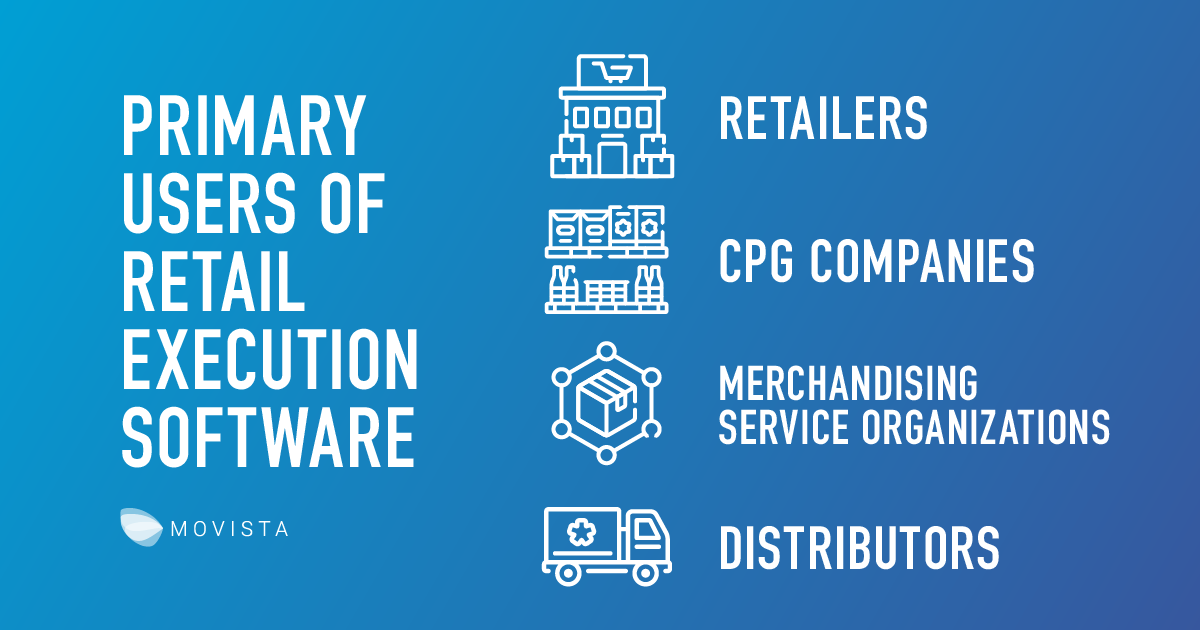

Who Uses Retail Execution Software?
Retail execution software serves any business type that sells, services, or merchandises products in a physical retail store. Retailers themselves are the most obvious fit for retail execution software, but the third-party teams who visit and complete work within retailers’ stores are also prime candidates.
In fact, when retail execution software first hit the market a few decades ago, it originally served field reps who visited stores and completed work on behalf of merchandising service organizations (MSOs) and/or Consumer Packaged Goods (CPG) companies (we’ll go into greater detail about these business types below).
Back then, field teams relied on phone calls, clipboards, and word of mouth to track, verify, and share performance with leadership. Retail execution software enhanced this process by giving field reps digital tools that not only improved the efficiency of their in-store work but also gave leadership greater visibility of that work.
Over the years, retail execution software evolved to address a much wider spectrum of execution needs, allowing other business types like retailers to leverage its capabilities. Now, some retail execution software is able to serve all teams who complete merchandising related work in retail stores, opening the door to exciting new possibilities for cross-organizational collaboration.
Because retail execution software encompasses so many things and serves different needs for different business types, let’s break down the four primary use cases for execution software.
CPG Companies – Field Teams
CPG companies have long been power users of retail execution software. Despite the rise of direct-to-consumer (D2C), many brands still rely on retailers to maximize their brand presence and drive sales across channels.
The finite shelf space and constant foot traffic of retail stores offer brands a competitive advantage over purely e-commerce marketplaces. In a store, shoppers only have a small selection of products to choose from in every category. This built-in scarcity can be extremely valuable to brands that can consistently execute in stores, which is why many CPG companies leverage RES.
CPG companies either have internal field teams who visit and service their brands in stores or they hire third-party labor providers (a.k.a., MSOs) to complete this work for them. In either scenario, RES is crucial for staying on top of replenishment and on-shelf availability, visual merchandising and planogram compliance, and sales performance per store or territory.
Without a retail execution software, CPG companies have little to no visibility of in-store work and field rep performance and lack the tools needed to execute quickly and flawlessly in today’s fast-paced store environment. Even if they hire a third party for store execution, they can indirectly leverage the benefits of a retail execution software by hiring an MSO who uses one (and most do).
.png)
cpg CASE STUDY
In 2012, a global confectionary manufacturer turned to Movista to help with the challenges surrounding their highly transient and dispersed field team. The amount of time the field reps were using to complete their web-based reporting was inefficient and costly.
Once they partnered with Movista and started to use our real-time execution software, the results they experienced radically changed how they worked for the better.
Merchandising Service Organizations (MSOs) – Field Teams
Merchandising service organizations are the original power users of retail execution software. CPG companies or retailers hire them to execute merchandising related tasks in stores because, well, execution is difficult and time-consuming. Instead of trying to build an internal execution team, many companies will rely on the expertise and experience of MSOs.
Because MSOs act on behalf of other companies, the stakes are a little higher for them. Not only are they expected to execute work quickly and flawlessly, but they are also required to validate and share performance with clients to prove their value and hold reps accountable. Proof-of-performance is important for any business completing work in stores, but the need for seamless and recurring data exportation makes it even more important for MSOs.
MSOs used to be limited in their scope of work: they would assign reps to stores, tidy up the shelves, and report back when they were done. But over the years, many MSOs expanded their offerings to provide clients with both specialized labor and strategic services. Some retail execution software evolved to meet these needs through advanced reporting and analytic features, giving MSOs an advantage over competitors who purely provide labor.
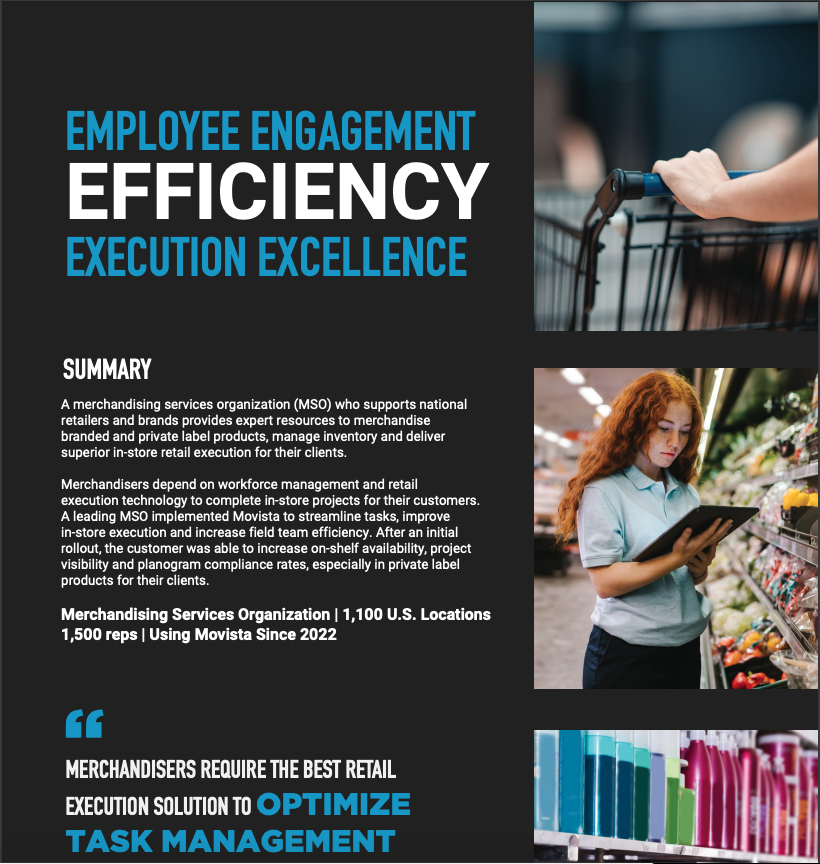
mso CASE STUDY
A merchandising services organization (MSO) who supports national retailers and brands provides expert resources to merchandise branded and private label products, manage inventory and deliver superior in-store retail execution for their clients. Merchandisers depend on workforce management and retail execution technology to complete in-store projects for their customers. A leading MSO implemented Movista to streamline tasks, improve in-store execution and increase field team efficiency. After an initial rollout, the customer was able to increase on-shelf availability, project visibility and planogram compliance rates, especially in private label products for their clients.
Distributors – Field Teams
Distributors are a relatively new user base for retail execution software. They act as intermediaries between product manufacturers and another entity in the supply chain. They purchase products from manufacturers and leverage their relationships to market and sell these products to retailers, wholesalers, or sometimes directly to consumers.
They play a similar role as merchandising service organizations in that they provide execution and strategic services to manufacturers and brands who don’t have the time or resources to adequately manage their in-store presence; the difference is that distributors purchase products and take full ownership over their distribution and sales. Smaller to mid-sized CPG companies are most likely to partner with distributors as they lack the resources to develop and maintain their own in-house distribution networks.
Because distributors take ownership over the products they purchase, they have the same incentives for using a retail execution software as CPG companies do. If anything, execution is more important to them because they are working with inherently thinner margins. Once they purchase products, it’s on them to oversee merchandising and drive sales, making retail execution software a crucial piece to their success.
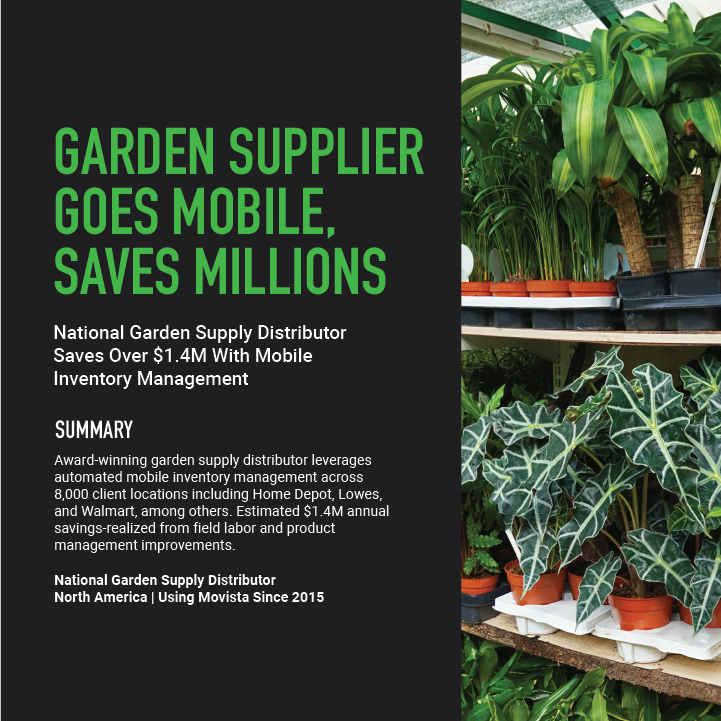
distributor CASE STUDY
A leading garden and live good merchandiser desired a more automated, traceable way to manage expiring products and relabeling. They have used Movista inside their 8,000 serviced store locations since 2015 and have been able to place $1.4 million dollars back into their annual budget because of the solution.
Retailers – Store Teams
Another emerging user base for retail execution software is retailers themselves. Because retail execution software was originally designed for field teams who visit stores, it took a while for the technology to evolve to meet the unique needs of store teams.
Unlike CPG companies, MSOs, and distributors, retailers only need retail execution software for in-store execution, not field rep deployment, route optimizations, and other service-oriented capabilities. Historically, most retailers have relied on home-grown solutions or a combination of disparate software to manage execution and track product and store performance, but now many retailers are turning to unified retail execution software to enhance their execution and gain greater visibility over work.
Some of the most powerful retail execution software use cases for retailers revolve around task distribution and monitoring, employee shift scheduling, communications, and vendor collaboration. Retailers have solutions for these capabilities already, but the advantage of a retail execution software like this one is that it unifies everything into one efficient and organized interface, not to mention the robust functionality that derives from years of retail-oriented tech development.
Vendor collaboration is perhaps the most exciting of these capabilities. A retail execution software platform allows for unprecedented ease of collaboration and cross-organizational visibility of work and performance. Even if third-party field teams don’t use the same execution software (although that’s ideal), retailers who invest time into onboarding their business partners’ information will gain new levels of accountability and executional coordination.
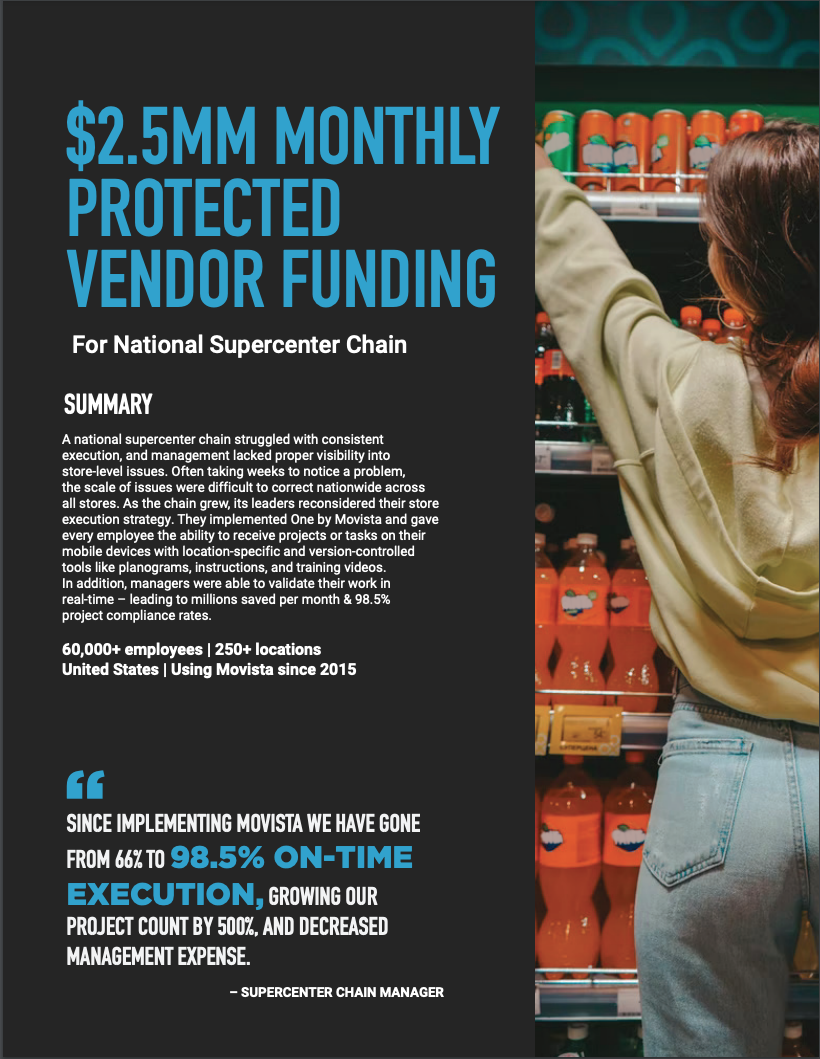
Retailer CASE STUDY
A large supercenter chain with 60,000+ employees struggled with consistent execution across their 242 locations. The management team lacked visibility into store-level issues in real-time, which led them to partner with Movista.
The Most Common Capabilities of a Retail Execution Software
We’ve touched on some of the key capabilities of retail execution software for each of the four main audience types, but let’s dive a little deeper into the standard functionality.
Not all providers will necessarily have all the below features, and the depth of each feature may vary, but this list should give you a solid understanding of the possible ways that retail execution software can help you elevate your in-store presence.
Task Management
This is the foundation of every retail execution software. It’s a way for store or field team leaders to efficiently create, assign, and distribute tasks to frontline employees, and it’s a way for frontline employees to stay on top of assigned work.
Most retail execution software supports both manual and automated tasking to address the different types of in-store work. Manually created tasks are great for special, one-off projects. Team leaders can provide detailed instructions, attach files and media, and push out tasks to frontline teams’ mobile phones for seamless coordination.
Automated tasking is ideal for recurring projects like on-shelf replenishment. Team leaders can define the parameters of their desired automations to reduce their administrative workload and improve productivity. For example, if items hit a certain threshold that makes them at-risk of being out-of-stock, an automated alert can be sent to the appropriate frontline employee to restock the shelves.
Item Management & Ordering
Only a few retail execution software offer item management and ordering functionality, but it is arguably one of the most powerful capabilities that a retail execution software can offer store and field teams as it allows for streamlined replenishment, reordering, and sales tracking.
Instead of restricting your item catalog and SKU information to an inventory management system that doesn’t account for real-time in-store product availability, you can integrate this data into a retail execution software so that frontline teams can inform and improve your inventory accuracy and speed-to-shelf.
For example, if a store associate or field rep notices a disparity in the amount of product on shelves and on record (due to either shrink-related losses or poor shelf replenishment practices), they can quickly flag the disparity so that your inventory management data is up to date with the most accurate information. This is especially important for honing in the accuracy of your demand planning to prevent costly over- or under-ordering.
You can also take things one step further (if you’d like to) by empowering your frontline teams to place order requests for items whenever they identify an out-of-stock risk. Large retailers are less likely to use this feature because they typically place orders in large batches months in advance, but it can be especially powerful for organizations with field teams as they can be more agile with their ordering and store-specific replenishment.
Lastly, item management gives teams a better way to track and analyze sales performance. Because frontline employees can inform inventory data from the source, team leaders are able to more quickly and accurately identify shifts in consumer behavior—and can better track individual product performance by store, territory, and season.
Scheduling
This is an important capability that streamlines field rep deployment (in the case of CPG companies, MSOs, and distributors) and shift scheduling (in the case of retailers).
RES enables field team leaders to easily identify the optimal store for each field rep based on customizable parameters such employee-to-store proximity, employee hour constraints, and store priority. For retailers, it enables store managers to easily schedule shifts to ensure that tasks never fall to the wayside and that store operations run smoothly.
Communications
Using texts, phone calls, and email to communicate about in-store execution no longer cuts it. You could use a third-party messaging platform, but it’s much better to have communications integrated into your existing retail execution software.
For example, if a frontline employee has a question about an assigned task (“I can’t find product X in the back-room storage”), he or she can submit a question to the appropriate person in the same mobile app they’re using to execute the task. This makes communication quicker, more organized, and more compliant.
RES typically supports all the familiar functionality of a comms module, such as:
- bidirectional 1-to-1 messaging
- group messaging
- team or company-wide announcements
An integrated comms module is slightly more important for store teams than field teams—as there is much more peer-to-peer collaboration at play—but both groups can benefit from streamlined messaging for the times when supplementary information is needed to adequately complete work.
Analytics & Reporting
Retail execution is about more than the coordination and completion of work—it’s also about measuring and analyzing the progress of that work, the performance of individual team members, and the performance of products over time by store. For these reasons, pretty much every RES has some level of analytics and reporting capability.
Having access to insightful dashboards in the same digital work hub used to plan and assign work is a great feature for leadership teams. It not only helps with short-term deployment and merchandising strategies but also long-term corporate level strategies around product selection and store allocation.
Proof of Performance
Somewhat related to reporting, proof of performance (POP) is a key feature for retail execution software, especially for remote teams. A store manager can walk the aisles and easily see whether shelves are being well-maintained, but field team leaders, historically, have had to rely on log sheets to gain minimal insights into performance.
A retailer may still leverage POP for intermittent store audits, but it is very much a feature geared toward CPG companies, MSOs, and distributors. The way it works can vary between providers, but typically it allows frontline teams to capture photos of completed work with their mobile device and quickly submit through the RES app for review and record keeping. Some RES providers are even experimenting with photo recognition AI to streamline this review process for admin users.
Retail Partner Collaboration
We talked about the benefits of a retailer embracing cross-organizational collaboration, but all entities in the store execution environment can benefit from it. The thing is, retail is a collaborative industry, especially in the context of a physical store environment; but historically, companies have operated in siloes, communicating on an as-needed basis, not being proactive with their coordination, and certainly not giving each other visibility into projected demand levels or production capacities.
Not too surprisingly, retail execution software has stepped in to fill the need for better, more streamlined retail-partner collaboration. And it makes sense: all RES must do to aid with cross-organizational collaboration is build data bridges between each party.
If the entire store ecosystem is unified through the same retail execution hub, you can imagine how much more efficient and precise teams could become. All the value-driving features of retail execution software would be extended and multiplied across each participating party.
The future of retail work is radically transparent and collaborative, and the early adopters of this new paradigm will be the ones best positioned to reap the benefits.

Is Retail Execution Software Worth the Investment?
Believe it or not, not all teams who work within a store environment use retail execution software, even if it would greatly benefit them. Instead, some companies opt for two alternatives:
- Building and maintaining a home-grown software solution
- Using a hodgepodge of disparate solutions that may or may not be designed for retail work specifically (the most common example being a heavy reliance on CRM software)
The first option may suffice for smaller organizations, but only if they have no plans of scaling their business. The larger their operations grow, the more unwieldy and cost-ineffective a home-grown solution becomes.
Software development is a domain all its own, and it requires significant financial and temporal investment that most companies cannot afford to make. A dedicated retail execution software partner can lift these burdens off the shoulders of retail teams and free them to focus on the type of work their business was built around.
The second option is tempting because it is usually less expensive than retail execution software, but what it saves in money it loses in value. Requiring your team to jump between disparate solutions is a recipe for inefficiencies and mistakes. And using software that isn’t designed specifically to address the executional needs of retail teams puts a governor on your success.
Why, then, have some organizations not adopted retail execution software? Well, it can be costly, and it often requires an intensive implementation and onboarding process. But as we will attempt to elucidate, the right RES can give your organization returns well beyond its investment.
The Quantitative Benefits of Using Retail execution software
We can’t speak for other retail execution software providers, but our solution has been able to provide companies with a wide range of tangible ROI. Here are some of the most common ones:
- Out-of-stocks: 12% reduction
- Labor costs: 8% reduction
- Top-line sales: 3% increase
- Promotional compliance: 99% achievement
The Qualitative Benefits of Using Retail execution software
Because retail execution software serves so many different types and sizes of businesses, quantitative benefits can sometimes be misleading. But regardless of your organization’s unique circumstances and makeup, you can expect the following improvements to your executional operations with the right retail execution software partner:
- Improved visibility of employee, store, and product performance
- Significant reduction in administrative workload
- More efficient and effective orchestration of tasks
- Improved inventory accuracy (and, therefore, forecasting accuracy)
- A dedicated support team who is available around the clock
- A long-term business partner who is as committed to your success as you are, who is constantly improving its product to better serve the always-changing needs of in-store teams
- An easily and infinitely raisable ceiling for executional success
Is Retail Execution Software Right for Your Company?
Only you can answer this question, but we can point you in the right direction. We’ve created a complementary retail execution software buyer’s guide for those interested in learning more about the finder details of retail execution software.
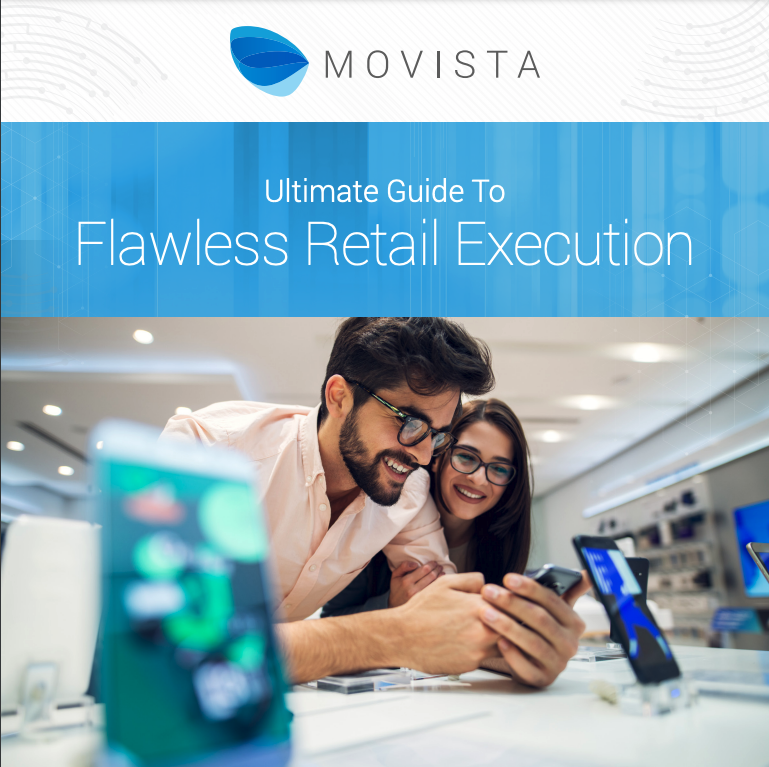
Free retail execution software buyers guide
A large supercenter chain with 60,000+ employees struggled with consistent execution across their 242 locations. The management team lacked visibility into store-level issues in real-time, which led them to partner with Movista.
If you’d rather cut right to the chase and talk to someone who can answer your questions on the spot, you can schedule a time to chat with our team below. And don’t worry, we won’t try to push you into a sale. We want to make sure that we’re the right fit for each other as much as you do.
About Movista
Movista is an enterprise-grade retail execution SaaS company that empowers store and field teams to better orchestrate in-store work and improve on-shelf availability.
We are revolutionizing the way retail teams collaborate so they can execute flawlessly in today’s dynamic store environment. Our solution unifies all key execution functionality into a single integrated desktop/mobile work hub that improves workforce productivity and in-store item management.
Learn more at www.movista.com.
Follow us on LinkedIn for regular retail industry insights.
Subscribe to our new educational LinkedIn Newsletter Shelf Help to stay in the know on the latest retail industry trends.

Movista Inc. is a Software as a Service (SaaS) company created by a team of retail veterans, merchants, and innovators who believe the future of retail work is radically transparent and collaborative.
To realize that vision, we've built a platform that is transforming the execution of all work by all teams in the retail ecosystem. It's safe to say our SaaS is world-class.
Copyright © 2023 All Rights Reserved. | Privacy Policy
